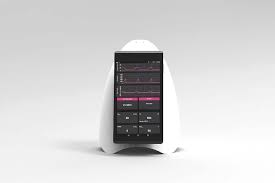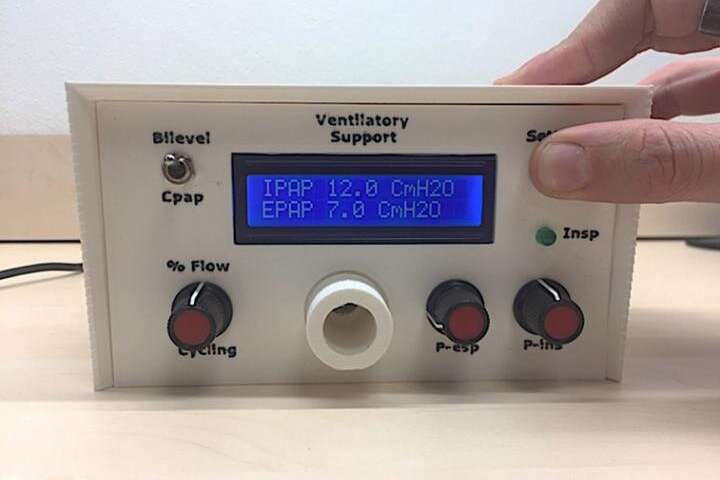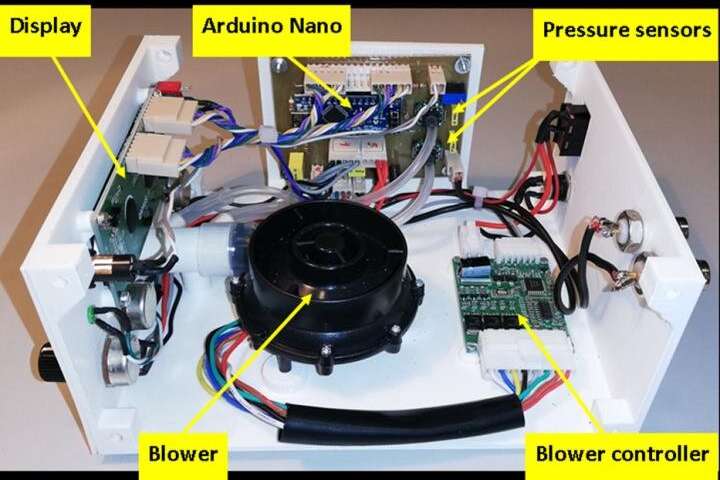COVID-19 Ventilators: The Two Best Innovations, An Indian US$1,700 Toaster-Sized Ventilator And A US$75 Open Source Ventilator From Spain
Source: COVID-19 Ventilators Apr 21, 2020 5 years, 7 months, 3 weeks, 17 hours, 59 minutes ago
COVID-19 Ventilators: Initially created by a robot scientist and a neurosurgeon to help India's poor, a toaster-sized ventilator is offering hope in the world's fight against the COVID-19 pandemic and demand is booming.
 The affordable High Specs Indian AgVa Ventilator
The affordable High Specs Indian AgVa Ventilator
The SARS-CoV-2 coronavirus at its most lethal attacks the lungs and in most cases it is the immunity’s own’ cytokine storm’s that damages the lungs, making ventilators which pump breathable air into a patient critical for hospitals around the world as they are swamped with COVID-19 cases.
Although the numbers of infected in India still considered small and where a nationwide lockdown is in force, production of AgVa's portable ventilator has shot up from 500 a month to 40,000 units per month. There are even plans underway to scale production to up to 160,000 units per month.
Indian neurosurgeon Dr Deepak Agrawal, who co-developed the device with robot scientist Dr Diwakar Vaish told
Thailand Medical News, "There was no way we could have foreseen something as big as this.”
The high specs ventilators is priced at around $1,700, the AgVa ventilator is a fraction of the price of conventional ventilators, which go for more than US$10,000.The product has also passed all EU regulatory standards and is pending US FDA review.
Initially, to boost preparedness for a surge in cases, the Indian government has banned the export of coronavirus-linked medical exports, including ventilators but recently reopened to exports after receiving massive orders from the US, Europe and Australia.
The AgVa plant near the capital New Delhi has been given permission to work flat out to make what could be a key weapon when India has to fully confront the pandemic and also to help its allies and supporting nations.
The AgVa ventilator which weighs just 3.4 kilos (7.5 pounds) will help move less critical patients back to their homes as their machine is easy to transport and install, and needs low power.

Dr Vaish commented, "In case you want to convert a hotel into an ICU, you can simply put this device and start working as it doesn't require other infrastructure."
India's biggest passenger car maker, Maruti Suzuki, has pledged to help AgVa ramp up production after the government called on all auto firms to contribute to the anti-coronavirus effort.
We desperately need your kind help! Please help support our site and our initiatives to propel and aid research by making a donation to help sustain the site. We are also trying to raise funds to help poor undocumented refugees who have no access to public healthcare during the COVID-19 crisis. Donations are accepted via paypal: h
ttps://www.thailandmedical.news/p/sponsorship
In 2016, seeing people queue for life-support equipment at the All India Institute for Medical Science in Delhi in 2016 convinced Vaish and Agrawal that there was an acute need for a cheap and portable ventilator.
Dr Vaish added, "ICU care is very expensive. In the private sector, even the richest of rich can't afford it for a long time."
Dr Aggarwal added, ”We avoided expensive imported parts to keep the cost low.”
To date, with its cash-starved health system, India has only around 120,000 ventilators, and experts who have seen the coronavirus crisis explode in Europe have warned this could become a catastrophic shortage for India.
Dr R.V. Asokan, secretary general of the Indian Medical Association, said the AgVa portable ventilator was the kind of innovation needed to fill health gaps.
Dr Asokan added, "It is a basic but high spec model which will serve in the current scenario as it is a straightforward oxygenation device and it would help COVID-19 patients.
Mrs Sunita Sharma, whose son was hospitalized for five years with a crippling nerve condition, was given one of the machines for free.
She added, "My husband and I had to take turns to stay with him at the hospital and that affected our lives. I was devastated when the doctors told me my son would have to spend the rest of his life on a ventilator bed. At least now I can stay home to take care of him and the rest of the household."
Thailand Medical News highly recommends this product after testing it. Unlike conventional ventilators that need proper training in order to use them, the AgVa ventilator is user friendly with an interactive panel that also has its own warning and monitoring functions.
Agva Company is also helping
Thailand Medical News to develop a low cost and portable 7 litre oxygen concentrator and the very compact size model is expected to debut in about 8 weeks’ time.
The Spanish Easy-to-Build US $75 Open-Source Arduino Ventilator With High-Quality Specs.
Meanwhile Spanish Biotech engineers have developed a ventilator that could support COVID-19-19 treatments in low-income regions or where supplies are limited.
 Low-cost, easy to build prototype ventilator during use. The ventilator can be used to
Low-cost, easy to build prototype ventilator during use. The ventilator can be used to
support COVID-19 treatment in low income regions of where ventilator supplies are
limited. Credit: Prof. Ramon Farré.
The low-cost, easy-to-build non-invasive ventilator is aimed at supporting the breathing of patients with respiratory failure performs similarly to conventional high-quality commercial devices, according to new research published in the
European Respiratory Journal. DOI: 10.1183/13993003.00846-2020
Typically, non-invasive ventilators are used to treat patients with breathing difficulty and respiratory failure, a common symptom of more severe coronavirus disease. Non-invasive ventilation is delivered using facemasks or nasal masks, which push a set amount of pressurized air into the lungs. This supports the natural breathing process when disease has caused the lungs to fail, enabling the body to fight infection and get better.
The new research provides a free to replicate, open-source description for how to build the ventilator. The researchers say the prototype ventilator could support treatment of coronavirus and other severe respiratory diseases in low-income regions or where ventilator supplies are limited.
The development and research study was led by Dr Ramon Farré, Professor of Physiology in the Unit of Biophysics and Bioengineering at the School of Medicine of the University of Barcelona, Spain.
 Display panel for the low-cost, easy to build prototype ventilator, which could be used
Display panel for the low-cost, easy to build prototype ventilator, which could be used
to support COVID-19 treatment in low income regions or where ventilator supplies
are limited. Credit: Prof. Ramon Farré.
Dr Farre told
Thailand Medical News, “In light of the ongoing coronavirus pandemic and the escalating need for respiratory support devices around the world, we designed a ventilator that can be built at a low cost using off-the-shelf components.The ventilator is intended to support hospitals and health systems that are struggling to meet the demand for ventilator support due to coronavirus and other severe lung diseases.”
We desperately need your kind help! Please help support our site and our initiatives to propel and aid research by making a donation to help sustain the site. We are also trying to raise funds to help poor undocumented refugees who have no access to public healthcare during the COVID-19 crisis. Donations are accepted via paypal:
https://www.thailandmedical.news/p/sponsorship
The biotech developers designed, built and tested the low-cost non-invasive ventilator with a small high-pressure blower, two pressure transducers and a controller with a digital display, which are available at a retail cost of less than US $75.
In order to assess the effectiveness of the ventilator prototype compared with a commercial ventilator, the research team tested the device using 12 healthy volunteers. The participants’ breathing was partially hindered by having them wear bands around the chest, mimicking obstruction at the upper airways to simulate different levels of chest tightness and breathing difficulty caused by disease.
The research participants wore face masks fitted over the nose to facilitate breathing and were asked to score the level of comfort or discomfort they experienced both with and without ventilator support.
The biotech developers observed no faulty triggering of changes to the levels of air pushed from the ventilator during use, and the team says it effectively supported spontaneous breathing rhythm, suggesting that the prototype assists natural breathing well. Further, they found that the feeling of breathing relief provided by the prototype was virtually the same as what was reported using the commercial ventilator.

T
he internal build of the ventilator prototype with labels indicating the off-the-shelf
components, including the blower and controller, display panel and pressure
transducers. Credit: Prof. Ramon Farré.
The biotech experts also carried out respiratory “bench testing,” where lung modeling is used to assess how well the ventilator supports the breathing of patients with different levels of airflow obstruction or restriction. The ventilator prototype was tested under 16 different simulated conditions, covering real-life settings where non-invasive ventilation is used in clinical practice.
Significantly, the bench test showed that, across all simulated conditions, the prototype ventilator worked effectively to support the lungs to operate efficiently and there was no faulty triggering.
Dr Farré added, “Our tests showed that the prototype would perform similarly to a conventional, high-quality device when providing breathing support for patients who, although with great difficulty, can try to breathe by themselves. This low-cost device could be used to treat patients if commercial devices are not available, and it provides clinicians with a therapeutic tool for treating patients who otherwise would remain untreated.”
The developers highlight that the prototype is a non-invasive ventilator; it is not intended for the most severely diseased patients in intensive care units, who are intubated and require a mechanical ventilator to take full control of the patients’ breathing, as the prototype only provides breathing support.
Dr Leo Heunks, a Professor in intensive care medicine from the European Respiratory Society who was not involved in the study commented, “Medical data suggests that around 80% of people who get COVID-19 recover without needing hospital treatment, but those who do develop severe symptoms can experience breathing difficulties, which is distressing and puts health systems under additional pressure. Low-cost solutions like the ventilator described in this paper could provide treatment for those patients, potentially improving outcomes and helping to alleviate pressure on health systems by reducing the need for more invasive types of ventilator support.”
The research paper includes an open-source description with full technical details on how to build the non-invasive ventilator is included in the research paper. The authors say that to build the device no prior knowledge of ventilation is required, and only basic engineering skills are needed.
For more on
COVID-19 ventilators and oxygen concentrators keep logging to T
hailand Medical News.
We desperately need your kind help! Please help support our site and our initiatives to propel and aid research by making a donation to help sustain the site. We are also trying to raise funds to help poor undocumented refugees who have no access to public healthcare during the COVID-19 crisis. Donations are accepted via paypal: https://www.thailandmedical.news/p/sponsorship




